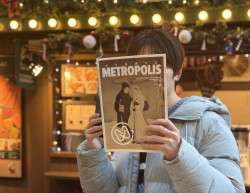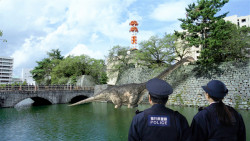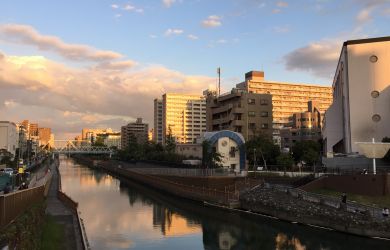
April 7, 2005
Ancient treasures
Explore untouched 900-year-old temples in Myanmar’s Bagan region
By Metropolis
Originally published on metropolis.co.jp on April 2005

Photos by Gabriela Brust
With the noisy roar of our rickety old taxi, we set off from Nyaung-U Airport along the dry, cracked road towards the Bagan Archaeological Zone. As we bounced like rag dolls across the creaking backseat of our taxi, I had my first glimpse of what was to become the most impressive of my Southeast Asian travel experiences. The dusty taxi window framed the scene of a mystical landscape, an image of Asia as it looked centuries ago.
Bagan’s story is eloquently written in the thousands of monuments and temples that lie over 40 square kilometers across the Bagan Plain. Situated in central Myanmar on the Ayeyarwady (or Irrawaddy) River, Bagan was once the most magnificent religious city in Asia. Today, it’s a spectacular concentration of ancient ruins of a scale largely unmatched anywhere else on the continent.
We traveled here in search of an adventure, for Bagan presented an opportunity to experience the “old” Asia, to visit temples and townships that have not seen the hordes of tourists passing through other parts of the region. And we were not disappointed. There were no ticket offices, long queues, or areas marked out of bounds. We were free to wander among the myriad temples, exploring this vast complex of ancient ruins as if on a solitary tour of discovery.
Across the Bagan Plain, the temples and stupa form a brocade of varying shapes, sizes and designs: large and striking, small and unimposing. The fired brick and plaster exterior of some have been left to crumble, while others, clothed in dull white stucco with remnants of gold trimming, stand majestic next to their less stately neighbors. Between the temples and stupa lie fields of millet, clumps of palm trees and other vegetation.

Some families still live within the temple complex, farming the fields and driving bullock carts with screeching, ungreased axles to keep evil spirits at bay. Others run roadside cafes and stores or sell screen prints and dusty old editions of George Orwell’s Burmese Days to the few passing tourists.
The temples of Bagan were built between the mid-11th and late 13th centuries at a time when Theravada Buddhism was zealously embraced in Myanmar. Bagan became a focal point for Theravada Buddhists and attracted pilgrims from across Southeast Asia. What concluded this extraordinary period in Myanmar’s history is a matter of considerable debate among the Burmese. Some believe that an army of Mongols led by Kublai Khan razed the city; others believe that it was abandoned owing to the threat of an invasion from China, leaving it, as Marco Polo described, as a playground for Kublai Khan’s “clowns and court jugglers” before it was left to slumber for centuries.
Our exploration took the form of early morning and late afternoon expeditions to the dusty plain on the rusty one-speed bikes we hired from our hotel. While we were not going to break any land speed records, we decided to decline the persistent offers of transport from horse and cart drivers and tour guides to weave through the temple complex by bike at whim.
We cycled from temple to temple, enticed into many by the faint sweet smell of incense. The few roadside cafes and teahouses bordering the edge of the temple plain were a welcome respite from the heat, where locals, their teeth blackened from chewing beetles out of little lacquered boxes, served curry and noodle soup. At sunset, as the sun splashed its last light over the plain, the golden glow off the temples and stupas made for a particularly inviting time to explore and even climb in search of the perfect view. Inside the temples, we tiptoed barefoot through dark corridors and up pitch-black staircases, stumbling upon statues of Buddha and hidden mosaics in corners so dark you needed a flashlight to see them, and we occasionally encountered monks in ochre robes at quiet prayer.
Making our way into one small temple, we were suddenly surrounded by the children of a family who had unofficially claimed it as their own. We soon found ourselves being mustered up staircases and through corridors to sections of the temple we would never have discovered alone. I was even given photography tips by the eldest son. This “grand tour” was not, however, without a price. We were soon presented with screen print after screen print, laid out on the dusty temple floor for our inspection and ultimate obligatory purchase.
At the Ananda Pahto, one of the largest and grandest of Bagan’s temples, we were informed that its precious gem, which had been stored in the temple spire for centuries, had recently been looted. A tour guide we met later in the trip explained that the looters “just climbed up one night, broke in and took it. Oh, and they left an empty water bottle in its place.” A water bottle? We were stunned by the audacity of the robbers. Looting of the temples may continue unabated as it has done for centuries. Nonetheless, the thieves can only chip away at the splendor of Bagan.
Note: There are obvious political issues that must be considered by anyone planning travel to Myanmar. It is for each traveler to decide whether or not staying away will accelerate political change.
There are no direct flights between Myanmar and Japan. Yangon International Airport and Mandalay International Airport are serviced from many major airports in Southeast Asia, the most common of which is Bangkok. Air Mandalay and Yangon Airways fly to Nyaung-U Airport from Yangon, Mandalay and Heho.
Due to Myanmar’s tropical climate, the best months to visit are between October are early March. Tourists are still particularly scarce between March and May, but beware of the high temperatures. The monsoon season is from May to September. Thanks to the privatization of accommodation facilities, there are now approximately 125 hotels and guesthouses in Old Bagan (which is nearest to the well-known temples), Nyaung-U, Bagan Myothit, and surrounding areas. Restaurant options are limited to high-end hotels or very small roadside cafes and teashops.
[geo_mashup_map]







